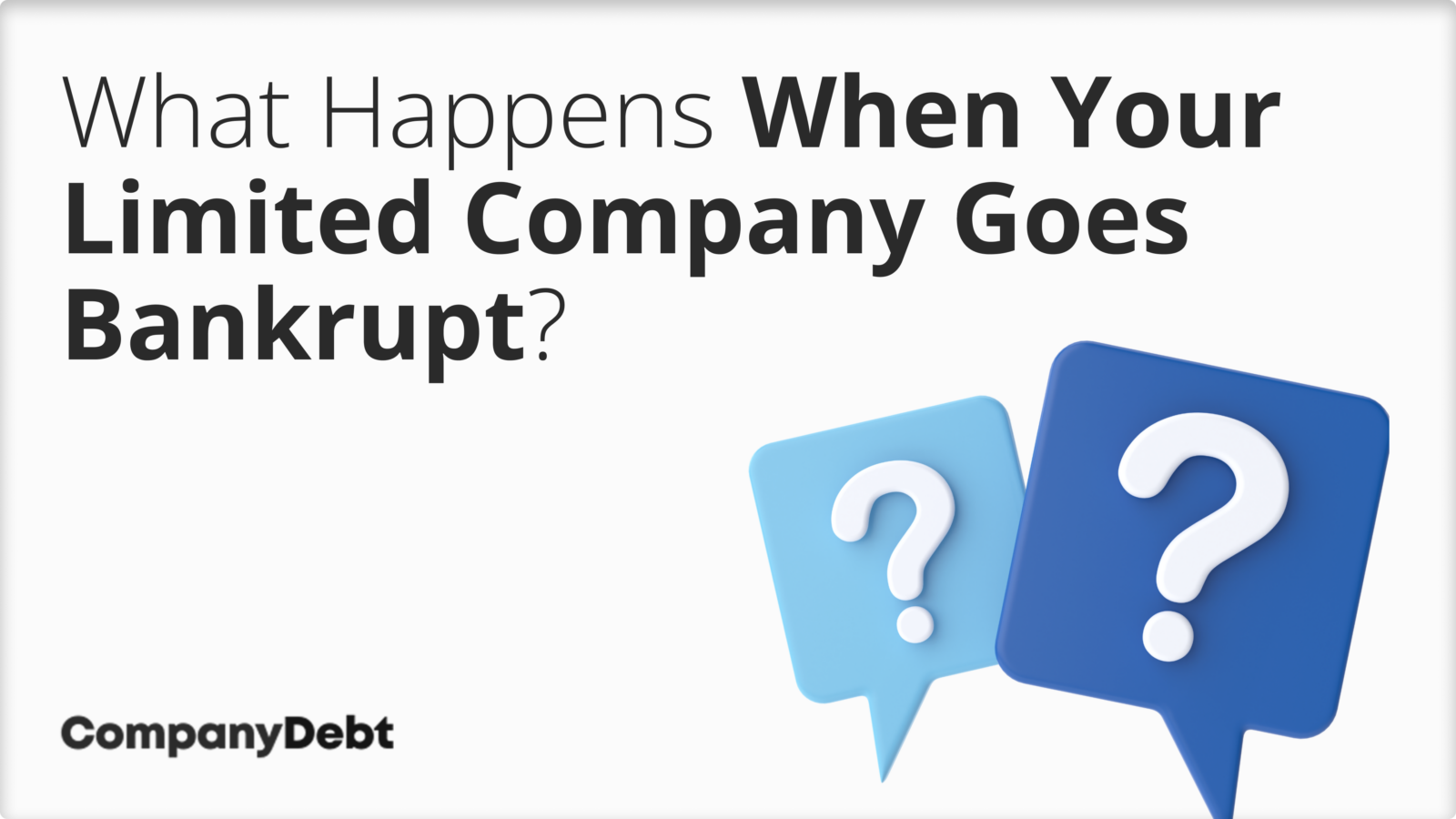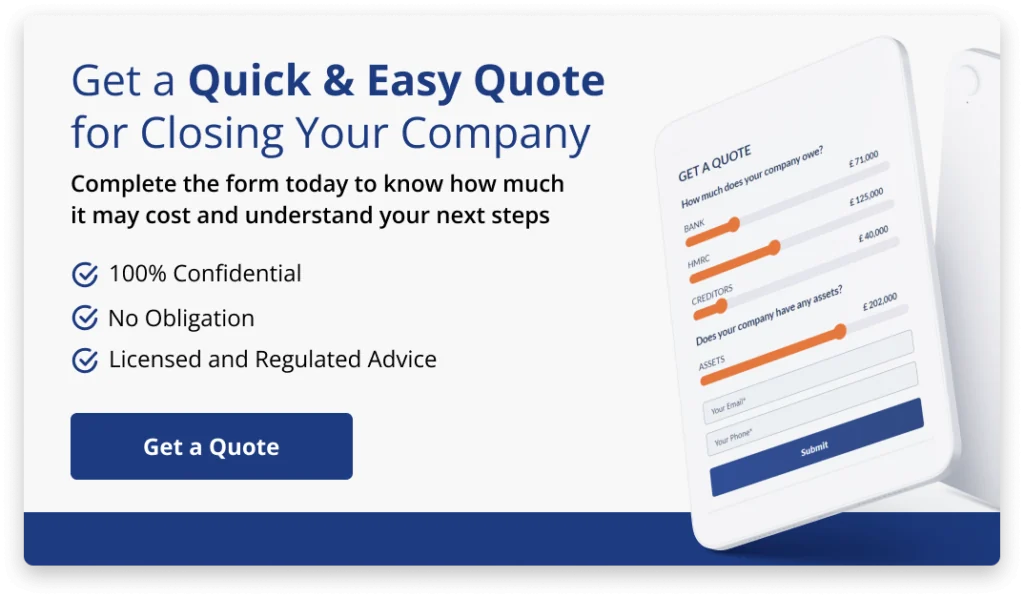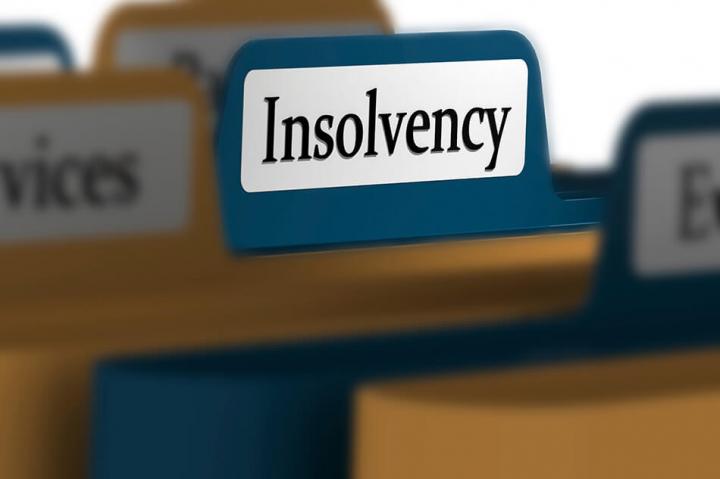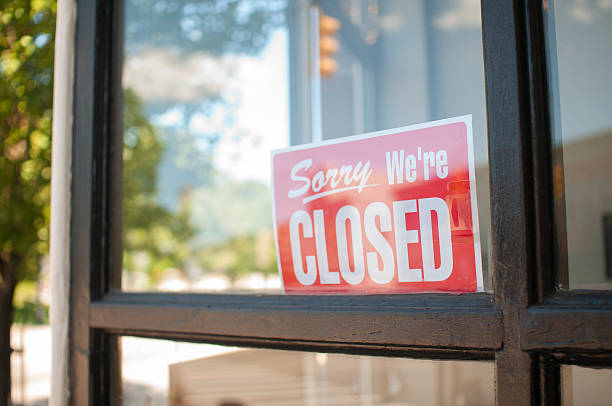
What is Company Bankruptcy and How Does it Work?
When a limited company is referred to as being ‘bankrupt’, it means it can’t pay its debts on time, or its liabilities exceed its assets. However, the accurate term is company insolvency.
As it is a commonly used term, we will use ‘company bankruptcy’ in parts throughout this article. However, keep in mind that the technically correct term is ‘company insolvency’.

Signs and Causes of Company Bankruptcy
For limited company directors, there are usually some clear warning signs you’re approaching the threshold of insolvency[1]Trusted Source – GOV.UK – Liquidation and Insolvency.
Key warning signs include:
- Consistently late payments to creditors, suppliers or employees
- Banks refusing finance
- Legal actions against your company
- Overdue taxes with HMRC
- Constant firefighting throughout the business
In some cases, this is caused by financial mismanagement and poor leadership decisions, but it’s equally likely to result from an economic downturn or increased competition.
It is important to note that these signs and causes often interrelate and that a combination of factors typically contributes to a company’s financial distress.
The most important thing is to keep a close eye on your balance sheet and act promptly if you can’t pay debts when due, or when liabilities exceed assets. Our insolvency test is designed to help you understand your position more clearly.
Can a Bankrupt Company be Rescued?
If your company is insolvent, you have several courses of action under UK law. These include closing the company voluntarily or appointing an insolvency practitioner to try to turn it around. I’ll outline some common business rescue processes below.
The choice will depend upon the company’s likelihood of returning to profitability in the future, and the best course of action for creditors.
HMRC Time to Pay arrangement (TTP)
If HMRC debts are your primary concern, you can pay them back via an instalment plan known as a Time to Pay Arrangement[2]Trusted Source – GOV.UK – Setting up a Payment Plan. These are typically offered for no more than twelve months, and only if you don’t have an existing agreement in place.
>>Read our full article on Time to Pay HMRC
Company Voluntary Arrangement (CVA)
A CVA is a powerful business rescue process that allows the company to reach an agreement with creditors to pay a percentage of debts over a specified period, potentially while continuing to trade.
CVAs can provide a lifeline by giving the company time to restructure its finances without the immediate threat of liquidation. They must be proposed by a licensed insolvency practitioner and agreed upon by at least 75% of creditors.
>>Read our full article on company voluntary arrangement
Administration
Administration is a process aimed at rescuing a company as a going concern. An appointed administrator oversees the company’s operations and devises a plan to pay creditors while trying to save the business. During this process, a moratorium protects the company from any legal action by creditors, giving it breathing space to restructure.
Administration is generally used for established businesses with the potential to return to profitability, but it can also lead to liquidation if the financial situation is too dire or a suitable rescue plan cannot be developed.
>>Read our full article on administration
What About Liquidation?
An insolvent liquidation process has the specific aim of closing a limited company. After the sale of any assets, cash is then redistributed to repay creditors. For directors, it’s a way of formally addressing unmanageable debts, while closing the company in an orderly, fair and equitable manner.
The liquidation process starts with the appointment of a liquidator (insolvency practitioner) who is appointed to handle the closure. Working with IPs is a legal requirement to ensure fair play for creditors: you can’t liquidate a company yourself.
Once appointed, the liquidator takes control of the company’s assets, which are valued and sold. The proceeds from the sale are used to repay creditors, prioritising secured creditors first, followed by preferential creditors such as employees, and finally, unsecured creditors.
After the assets are sold and proceeds distributed, the liquidator settles any outstanding claims and resolves disputes. The company is then formally dissolved, ceasing to exist legally, and any remaining debts are written off.
When a Company Goes Bankrupt, What Happens?
Whatever insolvency process a company chooses will significantly impact all stakeholders.
Here’s what typically happens to each stakeholder group, although the consequences will vary depending upon which process is chosen.
Employees
- Liquidation: All employees are made redundant and may not receive full entitlements.
- Administration: Jobs may be retained if the business continues or is sold, but redundancies do occur if necessary.
- CVA: Employees may keep jobs, but redundancies can happen if required to cut costs.
Regardless of the procedure, employees have statutory rights that include:
- Redundancy pay from the National Insurance Fund (subject to conditions and limits).
- Outstanding wages and holiday pay are preferential debts.
- Potential entitlement to notice pay and unfair dismissal compensation.
Employees should seek advice from the presiding insolvency practitioner during any insolvency situation. Or you can read HMRC’s guidance here: https://www.gov.uk/your-rights-if-your-employer-is-insolvent
>>Read our full article on What Happens to Employees in Liquidation
Directors
Directors’ powers become more restricted during insolvency proceedings [3]Trusted Source – GOV.UK – Section 103 Of The Insolvency Act 1986, and control of the company is transferred to the appointed insolvency practitioner (IP) upon engagement.
Directors have a duty to cooperate with the IP and provide all necessary information and assistance.
If directors are found to have acted wrongfully or fraudulently during the period preceding the insolvency, they may face legal consequences, such as disqualification under the Company Directors Disqualification Act 1986[4]Trusted Source – GOV.UK – Company Directors Disqualification Act 1986 or personal liability for company debts.
Insolvency practitioners have a duty to investigate directors’ actions as part of their role and file a directors conduct report.
>>Read our full article on What Happens to Directors in Liquidation
Shareholders
Shareholders are last in line to receive any distribution of assets during insolvency proceedings, and typically do not recoup their investment.
The reason for this is that there are often insufficient cash assets to repay creditors, which may leave less for shareholders.
Role of the Insolvency Practitioner
When a company becomes insolvent, an Insolvency Practitioner (IP) is appointed to manage the insolvency process. The IP is a licensed professional, usually an accountant or solicitor, who has done additional training to work with insolvent companies.
The IP’s primary role is to protect the interests of creditors and ensure that the insolvency process is carried out in accordance with the Insolvency Act 1986 and related legislation.
The IP’s main duties are to investigate the company’s finances, sell its assets, pay creditors, communicate with stakeholders, manage the company’s affairs, and conclude the insolvency process.
Post Company Bankruptcy
After a company becomes insolvent, directors have several key responsibilities and considerations:
- Cooperate fully with the Insolvency Practitioner (IP) and the Insolvency Service in ongoing investigations or proceedings.
- Seek legal advice if there are concerns about personal conduct or potential liabilities, such as wrongful trading or personal guarantees.
- Be aware of restrictions on reusing a similar company name in the future.
Failing to comply with these obligations or acting improperly can result in serious consequences, such as being held personally liable for company debts or being disqualified from serving as a director in the future.

Expert Support
For expert advice on limited company bankruptcy, contact Company Debt today. Our experienced team can provide the guidance you need to move forward with a full understanding of your options.
FAQs
Are there alternative solutions to company bankruptcy?
Yes, there are alternative solutions to company insolvency that don’t involve formal insolvency procedures. Some of these alternatives include:
- Negotiate with creditors directly to agree on revised payment terms, such as lower interest rates, longer repayment periods, or a partial debt write-off.
- Seek alternative funding sources, such as bank loans, asset-based lending, or invoice financing, to restructure your company’s debt and improve its financial position.
- Consider selling non-essential assets to raise funds and pay off debts.
- If your company is struggling but still has value, consider merging with another company or selling the business to a third party.
It’s important to note that while these alternatives can help businesses address insolvency, they may not be suitable for every situation. If your company is insolvent and unable to pay its debts, it may be necessary to consider formal insolvency proceedings to protect the interests of creditors.
Will I be able to continue working as a director after the company is bankrupt?
You can unless you have acted in such a way that you end up being banned from being a director.
What are my responsibilities as a director during the insolvency process?
A director’s chief responsibilities are to avoid any actions that may prefer one creditor over another and to cooperate with the insolvency practitioner during the information-gathering phase. This may involve providing details about the company’s assets and liabilities.
Can I continue trading if my company is insolvent?
No, directors must stop trading if the company is insolvent to avoid potential personal liability for wrongful trading.
How can I minimise the risk of personal liability as a director?
Directors should stay informed about the company’s financial position, act in the best interests of creditors, and seek professional advice when necessary.
The primary sources for this article are listed below, including the relevant laws and Acts which provide their legal basis.
You can learn more about our standards for producing accurate, unbiased content in our editorial policy here.
- Trusted Source – GOV.UK – Liquidation and Insolvency
- Trusted Source – GOV.UK – Setting up a Payment Plan
- Trusted Source – GOV.UK – Section 103 Of The Insolvency Act 1986
- Trusted Source – GOV.UK – Company Directors Disqualification Act 1986








